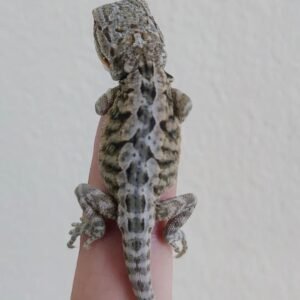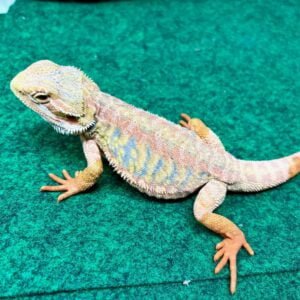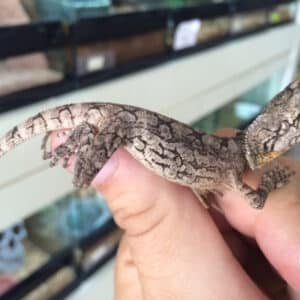Zero Bearded Dragon
$325.00 – $899.00
43 people are viewing this product right now
Zero bearded dragon or albino bearded dragon, is not something to be taken lightly. While they aren’t the most difficult animal to care for, they have a very particular set of needs that must be met in order for them to have healthy lives. This care guide is designed to teach beginner bearded dragon enthusiasts everything they need to know to get started.
Quick Facts about White (Zero) Bearded Dragons
| Species Name: | Pogona vitticeps |
| Common Name: | Bearded Dragon |
| Care Level: | Moderate |
| Lifespan: | 5 to 8 years |
| Adult Size: | 16 to 24 inches |
| Diet: | Omnivores |
| Minimum Tank Size: | 30-gallon tank |
| Temperature & Humidity | 75°F to 100°F and 20% to 40% |
Do White (Zero) Bearded Dragons Make Good Pets?
Bearded dragons make good pets for families or kids as long as there is a responsible adult who is willing to keep an eye on them. Although docile and gentle animals, these dragons require regular meals, maintenance, and attention that cannot be overlooked. They are still relatively easy to care for but require consistent care by someone who won’t forget to keep up on the maintenance.
Appearance
White bearded dragons are so intriguing because they lack color and sometimes even patterns. They tend to have more gray in cooler regions and bright white in hotter areas. Adults grow up to two feet long, though they are sometimes smaller than this. As a rare morph, these are harder to find and usually more expensive than others.
How to Take Care of White (Zero) Bearded Dragons
Habitat, Tank Conditions & Setup
Tank
Set up the bearded dragon habitat before bringing one home. Glass and plexiglass are the best materials to use for this pet. Mesh lids are the easiest to work with and allows you to view your pet easier as well. A 30-gallon tank should be the minimum size for your bearded dragon. Too small of spaces are possible, but they won’t mid more room no matter how large you decided to go.
Lighting
Bearded dragons are native to Australia, and they require a lot of light that mimics their natural environment. Give them a full-spectrum light source with UVA or UVB lights to stimulate their appetite, level their mood, and provides vitamin D to help them absorb calcium in their diets. They must have 12-14 hours of light every single day.
Temperature
Bearded dragons enjoy a basking spot where temperatures remain between 95°F and 110°F. Their entire tank shouldn’t be this hot, though. Try to keep the tank around 85°F for a warm and happy dragon.
Substrate
The substrate is the floor or soil that is in the bearded dragon’s habitat. Sand, pebbles, and wood chips are all dangerous for your bearded dragons. Instead, reptile carpet is the best substrate product if bringing home a new pet. If you are trying to save a little money, paper towel and newspaper are safe options as well.
| Tank Recommendations | |
| Tank Type: | 40-gallon glass terrarium |
| Lighting: | UVA/UVB light fixture for 12 hours per day |
| Heating: | Heating pad |
| Best Substrate: | Reptile carpet |
Feeding Your White (Zero) Bearded Dragon
White bearded dragons are omnivores and eat a variety of foods, with most of their nutrition coming from insects and vegetables. Some of their favorite foods to consume are crickets, worms, spiders, small rodents, fruits, flowers, lettuce, carrots, squash, zucchini, and beat greens.
| Diet Summary | |
| Vegetables: | 30% of diet |
| Insects: | 70% of diet– small crickets, worms, spiders |
| Meat: | Rarely or as a treat |
| Supplements Required: | Calcium and Vitamin D3 |
Keeping Your White (Zero) Bearded Dragon Healthy
Keeping up on housekeeping chores is the best way to keep your bearded dragon healthy. If the tank gets too dirty or they aren’t getting enough light or humidity, you could come across several problems.
Common Health Issues
Bearded dragons are prone to a handful of health problems like mouth rot, parasites, and respiratory infections. These are mostly due to poor cleaning habits or improper lights, heat, and humidity levels in their tank.
Are White (Zero) Bearded Dragons Friendly? Our Handling Advice
White bearded dragons are relatively docile and don’t mind being handled by an owner that they trust. If you plan to handle your bearded dragon, make sure you are in a safe space where they won’t be injured. Move your hands slowly toward them, so you don’t spook them and slide your hand under their belly. Keep one finger under their chin to support their head and slowly lift them, so their tail is resting on your forearm. Do not lift it up by its limbs or tail.
Shedding & Brumation: What to Expect
Young bearded dragons under 6 months of age shed every couple of weeks, but this slows down after they turn 1 year old. When around 18 months old, they should only shed once or twice a year.
How Much Do White (Zero) Bearded Dragons Cost?
Zero bearded dragons are rarer than other morphs and highly sought after. While you can get a regular bearded dragon for around $100, expect to pay at least $400 for this specific morph.
Care Guide Summary
Docile
Easy to handle
Well-rounded diet
Must be housed separately
Sensitive to surroundings
Requite lots of space

Final Thoughts
White bearded dragons are unique-looking animals that a lot of reptile-lovers want to get their hands on. Although they don’t have a lot of needs, keeping their habitat maintained does take some work and requires an adult to keep an eye on them. They work well as a family pet and are amazing to watch and interact with.
| AGE/SIZE | Hatchlings, Well Started Baby, Juveniles, Young Adults |
|---|
Only logged in customers who have purchased this product may leave a review.
$199.00 – $799.00


$299.00 – $599.00
Related products
Copyright © 2024 REDBOX REPTILES.













Reviews
There are no reviews yet.